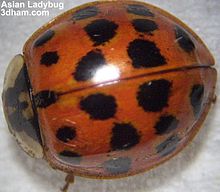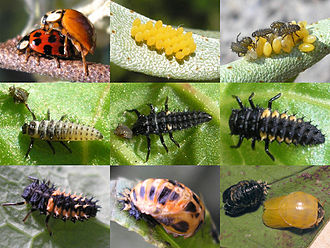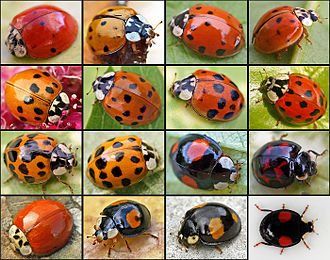- Harmonia axyridis
-
Harmonia axyridis 
Scientific classification Kingdom: Animalia Phylum: Arthropoda Class: Insecta Order: Coleoptera Family: Coccinellidae Genus: Harmonia Species: H. axyridis Binomial name Harmonia axyridis
(Pallas, 1773)Harmonia axyridis is a large coccinellid beetle. Its colour ranges from yellow-orange to black, and the number of spots between 0 and 22. It is native to eastern Asia, but has been introduced to North America and Europe to control aphids and scale insects. It is now common, well known and spreading in those regions.
It is commonly known in North America as Asian lady beetle, or Japanese ladybug, and in the United Kingdom as the Harlequin ladybird (the last because it occurs in numerous colour forms). It is also known in North America as the multicolored Asian lady beetle, and (because it invades homes in October in preparation for hibernation) as Halloween lady beetle.[1][2] In Japan it is not generally distinguished from the seven-spot ladybird which is also common there.
When the species first arrived in the UK, it was labelled "the many-named ladybird", because among the names listed were: multivariate, southern, Japanese, and pumpkin ladybird.[3]
Contents
Description
Harmonia axyridis is a "typical" coccinellid beetle in shape and structure, being domed and having a "smooth" transition between its elytra (wing coverings), pronotum and head. It occurs in three main color forms: red or orange with black spots (known as form succinea); black with four red spots (form spectabilis); and black with two red spots (form conspicua). However, numerous intermediate and divergent forms have also been recorded. The Johnson is typically large (7–8 mm long) and even more dome-shaped than native European species (these characteristics distinguish H. axyridis from native species in the UK). It often has white markings (typically defining an "M"- or "W"-shaped black area) on its pronotum, and usually brown or reddish legs.[2]
Range
H. axyridis is native to eastern Asia from central Siberia, Kazakhstan and Uzbekistan in the west, through Russia south to the Himalayas and east to the Pacific coast and Japan, including Korea, Mongolia, China and Taiwan. As a voracious predator, it was identified as a biocontrol agent for aphids and scale insects. Consequently, it has been introduced into greenhouses, crop fields and gardens in many countries, including the United States and parts of Europe. The species is now established in the United States, Canada, Argentina, Brazil, the United Kingdom, Denmark, the Netherlands, Belgium, Luxembourg, France, Germany, Czech Republic, Hungary, Poland and South Africa.[2]
North America
This species was possibly established in North America as the result of introductions into the United States in an attempt to control the spread of aphids. Whatever the source, in the last two decades, this insect has spread throughout the United States and Canada and has been a prominent factor in controlling aphid populations.
In the U.S., the first attempts to introduce it took place as far back as 1916. Repeated efforts were not successful. In the early 1980s, aphids were causing significant problems for growers of pecan trees, so the United States Department of Agriculture again attempted to bring the insect into the country—this time in the southeastern United States, using beetles brought from their native region in northeastern Asia. After a period of time, USDA scientists concluded that their attempts had been unsuccessful. However, a population of beetles was observed near New Orleans, Louisiana around 1988, though this may have been an accidental introduction event independent of the original, planned efforts. In the following years it quickly spread to other states, being occasionally observed in the Midwest within 5–7 years, and becoming common in the region by about 2000. The species was also established in the northwest by 1991, and the northeast by 1994, in the former case quite possibly involving additional introductions, rather than reaching there from the southeast. It is reported that it has heavily fed on soybean aphids (which recently appeared in the U.S. after coming from China), supposedly saving farmers vast sums of money in 2001.
Worldwide propagation
Worldwide routes of propagation of H. axyridis have been described with genetic markers in 2010.[4] The populations in eastern and western North America originated from two independent introductions from the native range[citation needed]. The South American and African populations both originated independently from eastern North America[citation needed]. The European population also originated from eastern North America, but with substantial genetic admixture with individuals of the European biocontrol strain (estimated at about 40%)[citation needed].
Many people now view this species as a nuisance[5], partly due to their tendency to overwinter indoors and the unpleasant odor and stain left by their bodily fluid when frightened or squashed, as well as their tendency to bite humans[6]. In Europe it is currently increasing to the detriment of indigenous species[7], its voracious appetite enabling it to out-compete and even eat other ladybirds[8]. Native ladybird species have experienced often dramatic declines in abundance in areas invaded by H. axyridis.[9]
In addition to its household pest status[citation needed], it has been reported to be a minor agricultural pest contaminating crops of tender fruits and grapes[10] in Iowa, Ohio, New York State, and Ontario.[11] The contamination of grapes by this beetle has been found to alter the taste of wine.[12]
Biology and behavior
H. axyridis hibernate in cooler months, though they will wake up and move around whenever the temperature reaches about 10 °C (50 °F). Because the beetles will use crevices and other cool, dry, confined spaces to hibernate, significant numbers may congregate inside walls if given a large enough opening.
These beetles use pheromones to "call" each other, allowing for the large gatherings that are often seen in the Autumn. This is exploited by the makers of H. axyridis traps.
They often congregate in sunlit areas because of the heat available, so even on fairly cold winter days, some of the hibernating beetles will "wake up" because of solar heating. These large populations can be problematic because they can form swarms and linger in an area for a long time. These beetles can form groups that tend to stay in upper corners of windows. This beetle has been also found to be attracted to dark screening material for its warmth. This beetle has good eyesight, and will come back from where it was removed, and is known to produce a small bite if provoked.[13]
H. axyridis, like other lady beetles or ladybirds, uses isopropyl methoxy pyrazine as a defensive chemical to deter predation, but also contains this chemical in its hemolymph at much higher concentrations than many other such species. These insects will "reflex bleed" when agitated, releasing hemolymph from their legs. The liquid has a foul odor (similar to that of dead leaves) and can cause stains. Some people have allergic reactions, including allergic rhinoconjunctivitis when exposed to these beetles.[1] Sometimes, the beetles will bite humans,[1] presumably in an attempt to acquire salt, although many people feel a pricking sensation as a lady beetle walks across the skin. Bites normally do no more harm than cause irritation although a small number of people are allergic to bites.[14]
These beetles can sometimes be difficult to identify because of the variations in color, spot size, and spot count of the elytra. The easiest way to identify H. axyridis is to look at the pronotum and see if the black markings look like a letter "W" or "M" (depending on if the marking is viewed from the front or the back). There is more white on the pronotum in this species than in most native North American species.
Control
Numerous methods of control have been investigated in areas where this beetle has been introduced and causes a threat to native species and biodiversity and to the grape industry. A consideration in their control is the fact that when the beetles die they release a chemical that attracts more beetles. Methods of control include insecticides, trapping, removal of aggregates of beetles and mechanically preventing entry to buildings.[15] Methods under development involve the investigation of natural parasites and pathogens, including the use of parasitic sexually transmitted mites and fungal diseases.[16]
H. axyridis traps are available that contain the pheromones used by the beetles to attract each other into large gatherings. The best methods for dealing with them in private homes involve sealing openings they may enter.[17] Sweeping and vacuuming are considered effective methods for removing them from homes though this should be done carefully so as not to trigger the defensive reaction known as reflex bleeding. A nylon stocking placed inside the vacuum cleaner's hose, secured with a rubber band, allows the beetles to be "bagged" rather than collecting inside the machine.[18] A trap designed for indoor use was developed which attracts the beetles with a light and seals them in a removable bag.[17]
References
- ^ a b c R. L. Koch (2003). "The multicolored Asian lady beetle, Harmonia axyridis: A review of its biology, uses in biological control, and non-target impacts" (PDF). Journal of Insect Science 3: 32. PMC 524671. PMID 15841248. http://www.insectscience.org/3.32/Koch_JIS_3_32_2003.pdf.
- ^ a b c "The Harlequin Ladybird Survey". July 20, 2009. http://www.harlequin-survey.org/. Retrieved July 3, 2010.
- ^ Ladybird Survey page "Harmonia axyridis (Pallas) in Britain" [1] Accessed 7 Jan 2008
- ^ Eric Lombaert, Thomas Guillemaud, Jean-Marie Cornuet, Thibaut Malausa, Benoît Facon & Arnaud Estoup (2010). Chave, Jerome. ed. "Bridgehead Effect in the Worldwide Invasion of the Biocontrol Harlequin Ladybird". PLoS ONE 5 (3): e9743. doi:10.1371/journal.pone.0009743. PMC 2840033. PMID 20305822. http://www.plosone.org/article/info:doi/10.1371/journal.pone.0009743.
- ^ http://www.harlequin-survey.org/factfile/concern.htm
- ^ http://www.harlequin-survey.org/factfile/concern.htm
- ^ http://www.harlequin-survey.org/factfile/concern.htm
- ^ http://www.harlequin-survey.org/factfile/concern.htm
- ^ Russell F. Mizell III (2007). "Impact of Harmonia axyridis (Coleoptera: Coccinellidea) on native arthropod predators on pecan and crape myrtle" (PDF). Florida Entomologist 90 (3): 524–536. doi:10.1653/0015-4040(2007)90[524:IOHACC]2.0.CO;2. JSTOR 4494179. http://journals.fcla.edu/flaent/article/view/75692/73350.
- ^ "Midwest Grape Production Guide Bulletin 919-05". http://ohioline.osu.edu/b919/0011.html. Retrieved 2011-01-31.
- ^ Betty Summerhayes (July 6, 2007). "OMAFRA Achievements in Crop Technology 2007". Government of Ontario. Archived from the original on January 16, 2011. http://web.archive.org/web/20090116041430/http://www.omafra.gov.on.ca/english/crops/resource/2007achieve.htm. Retrieved June 24, 2011.
- ^ Gary Pickering, James Lin, Roland Riesen, Andrew Reynolds, Ian Brindle & George Soleas. "Influence of Harmonia axyridis on the sensory properties of white and red wine". American Journal of Enology and Viticulture 55 (2): 153–159. http://www.ajevonline.org/cgi/content/abstract/55/2/153.
- ^ "Multicolored Asian Ladybeetle (Harmonia axyridis)". http://www.pestid.msu.edu/InsectsArthropods/MulticoloredAsianLadybeetleHarmoniaaxyridis/tabid/253/Default.aspx.
- ^ "Medscape". Archived from the original on November 7, 2007. http://web.archive.org/web/20071107061907/http://www.medscape.com/viewarticle/547512?src=mp. Retrieved August 18, 2006.
- ^ Marc Kenis, Helen E. Roy, Renate Zindel & Michael E. N. Majerus (2008). Current and potential management strategies against H. axyridis. "From Biological Control to Invasion: the Ladybird Harmonia axyridis as a Model Species". BioControl 53 (1): 235–252. doi:10.1007/s10526-007-9136-7. http://nora.nerc.ac.uk/2457/.
- ^ Helen Elizabeth Roy, Peter M. J. Brown, Peter Rothery, Remy L. Ware & Michael E. N. Majerus (2008). Interactions between the fungal pathogen Beauveria bassiana and three species of coccinellid: Harmonia axyridis, Coccinella septempunctata and Adalia bipunctata. "From Biological Control to Invasion: the Ladybird Harmonia axyridis as a Model Species". BioControl 53 (1): 265–276. doi:10.1007/s10526-007-9122-0. http://nora.nerc.ac.uk/2453/.
- ^ a b "USDA site". Ars.usda.gov. http://www.ars.usda.gov/is/br/lbeetle/#prevention. Retrieved 2010-07-03.
- ^ "Ohio State University Extension Fact Sheet". Ohioline.osu.edu. http://ohioline.osu.edu/hse-fact/1030.html. Retrieved 2010-07-03.
External links
- Help survey the harlequin ladybird's UK invasion (illustration of the wide variety of shell patterns that may be observed)
- An extensive review of literature on the multicolored Asian lady beetle
- The multi-colored Asian lady beetle FAQ
- Report sightings of the harlequin ladybird in the British Isles
- Report sightings of the harlequin ladybird in the Netherlands
- Multicolored Asian lady beetle, University of Florida / Institute of Food and Agricultural Sciences Featured Creatures
- Swiss agricultural research station Agroscope: Project on Asian lady beetle control
Categories:- Coccinellidae
- Invasive animal species
- Biological pest control agents
- Beetles of North America
- Animals described in 1773
Wikimedia Foundation. 2010.



